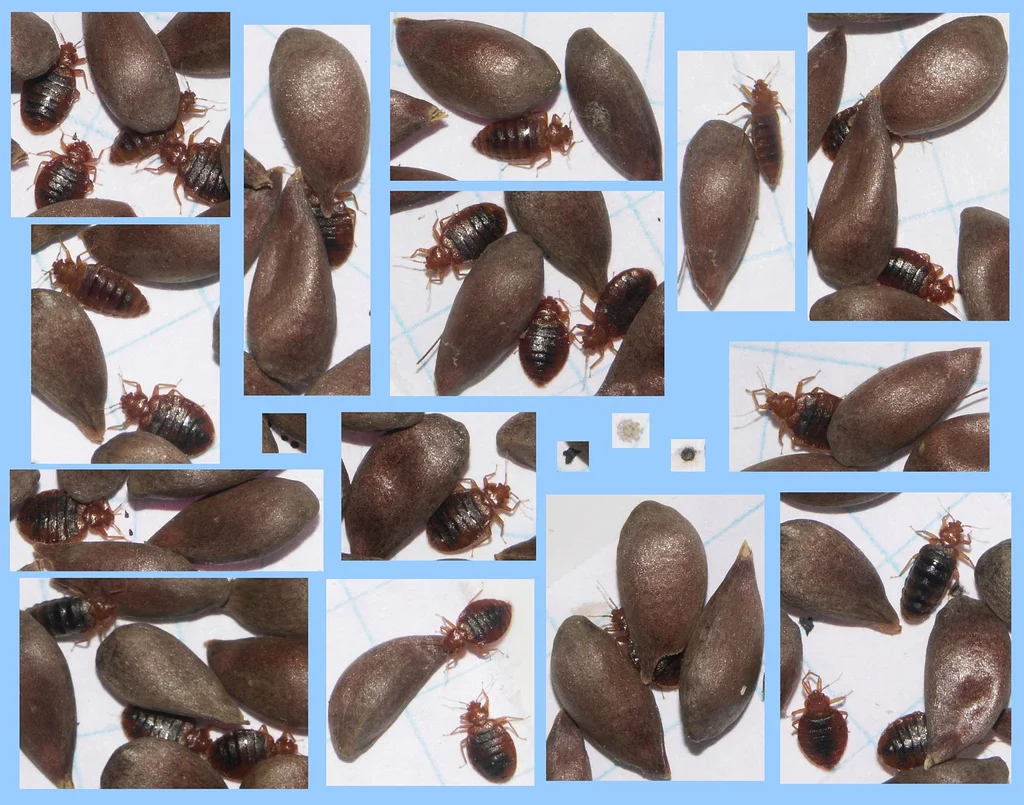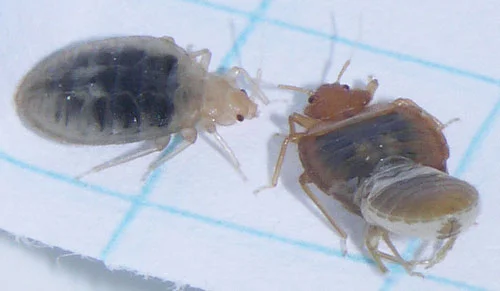Ontario has the dubious honour of the top five worst Canadian bed bug cities.
American Top 50 Bed Bug Hot Spots
Orkin Pest Control has released their annual compilaton of the 50 worst bed bug cities in the USA. Hopefully, the city you plan to visit this winter is not among the list. If it is, be sure to follow their SLEEP tip to evade these hitch-hikers - Survey, Lift, Elevate, Exam, and Place. Read this article for a list of these bed bug cities and the details of SLEEP.
Effective Bed Bug Repellent for Luggage - Maybe...
Protect your luggage
from bed bugs?
A study at Connecticut Agricultural Experiment Station and Bedoukian Research, Inc., showed promise to reduce the number of bed bugs attracted to the dirty laundry in luggage. The Journal of Medical Entomology, published John Anderson, Ph.D., and colleagues research on the effectiveness of eight compounds to reduce the risk of picking up hitchhikers.
It will be awhile before any of these products hit the market, but it does look promising and although not 100% effective, the products may be worth the price for that extra edge of reassurance. Remember - doing a visual search yourself of the bed and headboard - before you unpack your luggage is still the best preventative step when travelling; along with storing your luggage in the shower stall or bathtub and also isolating your dirty laundry in a zip lock bag.
Chili, The Weevil Detection Dog, To The Rescue!
Another K9 scent detection dog to the rescue. Chili, has the ability to protect millions of dollars, protect industry jobs and guide the greenhouse industry into a new chapter of pest detection.
A Feel Good Story About A Bed Bug Dog
Found at the side of the highway to a career as a scent detection bed bug sniffer.
Dryer Sheets Repel Bed Bugs - NOT!
American Board of Social Services office mistakes dryer sheets as an effective bed bug tool to repel the pest.
Introducing Lillie Loo - our latest bed bug dog
Meet Bed Bug Mutts' latest bed bug sniffer dog Lilli Loo.
A Tale of Two Species of Bed Bugs
Mark Sheperdigian delves into the "The Great Bed Bug Resurgence", in a recent blog post of the Pest Management Professional. He reviews the impact of the common bed bug and the tropical bed bug; seems one or the other is dominant depending upon the location world wide. Read the article here: Bed Bugs: A Tale of two Species
Principal author of the Australian Bed Bug Code of Practice, Stephen Doggett, clarified in the comments section:
“ the tropical bed bug is the most prevalent species between the latitudes of roughly 30 degrees north and 30 degrees south. Thus in addition to Singapore and Malaysia, this also includes Africa, India, Australia, and some of the first reports of the species were from South and Central America.”
Every Little Bit Helps In The Bed Bug Fight
What is a hotel to do with bed linens that no longer meet their standards, yet remain in good condition with serviceable life remaining?
The bed sheets and blankets could be collected and distributed to families in social housing that have had to discard their linens due to the ravages of a bed bug infestation.
Kudos to the Hyatt Regency Vancouver - for doing just that - donating serviceable bed linens to families suffering from bed bugs.
The hotel also donates surplus food that had been intened for conventions and went unused. Angel Food Runners a program of the Greater Vancouver Food Bank Society) distributes the food where it’s most needed.
How did this win-win relationship develop? Rita Fung, Hyatt's HR Manager, contacted the Vancouver Sun looking for solutions to avoid food waste, who put them in touch with Strathcona Community Centre, who connected them with the Angel Food Runners. Business and Comunity working together.
Bed Bug Cues and Miscues
CTV’s Canada AM recent report on the growing bed bug problem, “Don’t let them bite: Why bed bugs are worse than ever” delivers sound information and repeats a few perpetual bed bug myths.
First, it is important that this problem has spread from urban centres to rural areas and they are not stopping or slowing down, with bed bug reports up 20 percent from 2013:
“They’ve really got a good foothold in Canada and the United States, and we don’t see that changing any time soon”
Heimback made some other very good points – an infestation is not linked to one’s socioeconomic status; they are simply a pest of opportunity. "Anyone can get bed bugs," he said. "The challenge that we see is that certain people can't afford to get rid of them." And that do-it-yourself products may spread the infestation, increasing the costs and labour needed to kill them. A professional's integrated approach combines several different tools, specialized vacuums, steam, residual spray and diatomaceous dusts, attacking this difficult pest on several fronts.
A Bed Bug And An Apple Seed?
Unfortunately, in describing the bed bug’s appearance, the article perpetuated the reference to the “size, shape and colour of an apple seed”. This comparison has been a pet peeve of entomologist, Lou Sorkin. A picture is worth a thousand words (below). Those adult bed bugs are quite a bit smaller than the apple pips. To read more on the comparison, there is a blog post on Bedbugger.
Both male and female bed bugs, fed and unfed, along side apple seeds for comparison. Blue lines are 1/4 inch. Photo courtesy of Lou Sorkin.
As for the colour, nymphs (immature bed bugs) are lighter in colour, especially the 1st instar before the first blood meal. Recently molted nymphs also have a different appearance colour-wise, as exhibited by this photo of a recently shed female bed bug. Not to mention, recently fed bed bug nymphs are a bright red; as the meal digests the colour turns darker.
Bed bug on right is in the process of shedding its skin; bug on left recently moulted and is noticeably paler in colour. Blue squares are 1/4 inch. Photo courtesy of Lou Sorkin.
As for the size, bed bugs are usually 4-5 mm, not 3 mm quoted in the article. Keep in mind, a recently fed adult bed bug is more like 7 mm in length. The nymphs are the same general shape of the adult bed bug but start at 1 mm.
Feeding, Bite Mark and Blood Smear Miscues
As for the quote: "they only emerge to feed late at night”, don’t be so sure. If you work nights, they will adapt to your schedule, or if competition for food is high, they will come in search of a blood meal day or night.
The article references their bite as similar to a mosquito bite. Keep in mind, the bite-mark is an allergic reaction – some people are not allergic and have no reaction at all; others suffer a strong allergic reaction complete with severe itching and a bulbous swelling. The bite mark is an indication that something is up, but it is not evidence the cause is bed bugs. Mosquitoes, fleas and carpet beetles, are the more common pests that cause bite-like skin reactions.
The article identifies other signs of an infestation as “leftover insect husks and little back droppings, to blood spots on the mattress”. The first two are right on, the last one, not so much.
Three cast skins of 5th stage instars. Photo courtesy of Lou Sorkin.
The husk, or exoskeleton, looks just like the bug, complete with six legs and two antennas, but is a honey-transparent colour. To become an adult, the nymph takes five blood meals and after each, sheds its skin – the husk.
The black droppings are the fecal deposits and are the most common sign found. As the spotting is digested blood, they are black or dark brown in colour. When deposited on a substrate like paper or fabric which absorbs the liquid before it dries it resembles mould spots. If deposited on a surface like plastic, vinyl or finished wood, the liquid is not absorbed and dries to a round bump, something like a braille mark. For accurate identification of bed bug fecal spotting, the Bed Bug Blue Fecal Detection kit is handy to avoid mistaking mascara or pen marks as bed bug fecal.
Bed bug harbourage around staples on tack strip for upholstered furniture. Note the egg is empty. Photo courtesy of Lou Sorkin.
Blood spotting or smears on pillow. Note the colour is red, while bed bug fecal is dark brown or black as it is digested blood.
As for isolated blood spots as a sign of bed bugs – similar to bite-like marks, red blood smears on mattresses or bed linens is an indication that something is up, just not necessarily bed bugs.
The key messages, as stated by Heimbach, were: “They know how to live unseen", along with “The key is to learn to identify them". Education is everyone’s first line of defense. Learn to recognize them in all their life stages, and learn to recognize their signs – the cast skins and the fecal spots. Bookmark our gallery of bed bug mug shots - chances are you are going to need to reference it sooner or later.
More Bed Bugs Are Coming
Look to the past to predict the future and bed bug futures are no different.
Bed Bug Buzz — The Latest High
The latest bed bug hype - a bed bug 'buzz' - is a rehash of an ABC video on hash oil.
Newly Discovered Ostrich Bug Leads to Spread of Bed Bugs
Once thought mythical, the parasitic Ostrich Bug (Cimex ridiculous) has been confirmed.
Bed Bug Vermin In Vancouver Courtrooms Continues
An on-going bed bug infestation (along with rodent vermin) at Vancouver's Criminal Court location, 222 Main Street, is once again in the media spotlight.
Devil Bed Bug Monster Found – Happy Halloween!
Halloween creepy - It’s either a rare genetic mutation, an entirely new species of bed bug, or the common bed bug is evolving into something rather sinister.
Bite Me: The Bed Bug Invasion
CBC's the Doc Zone will present a 1-hour documentary on the growing and pervasive bed bug problem. Shot in Canada, the US and Thailand, the film exposes what experts are labelling a 'global pandemic'.











